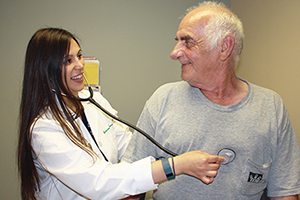By BETSY TAYLOR
As a resident and then as a hospitalist at Saint Agnes Hospital in Baltimore, Dr. Shannarose Guma said she treated many patients who could have avoided hospitalization if only they'd had access to routine care.

Dr. Shannarose Guma examines Wendell Shore during his recent visit to her Saint Agnes Medical Group office in Baltimore.
Now, she's able to provide just that care, working as a primary care physician as part of an expanded practice in offices on the campus of Saint Agnes Hospital. Saint Agnes began building up its primary care services in Baltimore about two years ago in a strategic initiative to better link urban patients — many of whom don't have cars — to a primary care practice within walking distance or a short bus ride from home.
The improved access allows patients like 71-year-old Wendell Shore, who lives nearby, to see their doctors regularly. Shore visits Guma about every three months; she helps him manage several conditions. Shore, who is insured by Medicare and Medicaid, said he now tries to use the emergency room only in an emergency, a shift from his past behavior.
He appreciates his ready access to Guma. "You never know when you're going to need a doctor," he said. "You might have to go clear across town, and that's no good."
Ascension's Saint Agnes Hospital, which is part of St. Agnes HealthCare, is not alone in rethinking how it provides care. Hospitals across the state have been working to increase the value of their services since Maryland's global budget revenue model took effect about a year and a half ago, Maryland hospital executives said.
Rate regulation
Under the model, each acute care Maryland hospital has a capped, predetermined revenue base amount that each hospital agrees to with a state agency, the Health Services Cost Review Commission. Caps are based on the size of the populations each hospital serves. (Primary care practices are not included in the global budget revenue model; and some rural hospitals operate under a financing model called total patient revenue.) The global budget revenue model is aimed at reducing per capita hospital expenditures and at improving patient outcomes. On Jan. 1, 2014, Maryland and the Centers for Medicare and Medicaid Services implemented this new financing structure.

Topper
For decades, Maryland has operated the nation's only all-payer hospital rate regulation system. "Maryland is the only state in the country in which all payers — Medicare, Medicaid, commercial insurance and the uninsured — are charged rates set by an independent commission," said John Colmers. He chairs the Health Services Cost Review Commission in Maryland, a regulatory agency that sets rates for all payers in Maryland's 46 acute care hospitals. Colmers is also Johns Hopkins Medicine vice president for health care transformation and strategic planning.
The Maryland commission was established in 1971. It began setting hospital rates in 1974 for nongovernmental payers. The current all-payer system was enabled by a Medicaid waiver from 1977, in which federal health insurance programs agreed to pay hospitals based on rates set by the Health Services Cost Review Commission. Reimbursement rates differ based on an individual hospital's cost structure, said John Topper, Mercy Health Services' executive vice president and chief risk officer.
Hospitals still bill and collect from each payer, but they bill all payers the same amount for the same service, said Justin Deibel. He is senior vice president and chief financial officer for the Baltimore-based health care system Mercy Health Services, which operates a stand-alone hospital, Mercy Medical Center in Baltimore. "So if a Blue Cross patient comes in for our services, we bill Blue Cross the same amount as we would for a Medicare patient or any other insurance," he said by way of example.
New math

Deibel
Each year adjustments are made by the Health Services Cost Review Commission to update each hospital's global budget, based on inflation, patient volumes, service mix and other factors. Deibel explained, "The Health Services Cost Review Commission has mechanisms in place to provide for an annual inflation update plus hospital-specific adjustments for population/patient demographics, uncompensated care and quality programs, et cetera. The commission also settles up any over- or undercharges versus the approved cap from the prior year.
"The cap is monitored monthly and as we set charges to achieve the cap," Deibel said. If patient volumes trend up, a hospital can gradually reduce rates to offset the volume increase. If a hospital finds, due to increased preventive care, that it is not on track to meet its cap, it would increase charges up to the cap and would keep funds it saved, Deibel said.
Under the model, all Maryland hospitals must show quality improvements, such as reductions in their 30-day hospital readmissions rate and hospital acquired conditions rate. Maryland will limit hospital revenue growth to 3.58 percent per year from 2014 through 2018. Maryland is working to save Medicare $330 million over those five years. Colmers said that figure is based on beating the projected national rate of increase in per capita hospital spending for Medicare by about a half percent a year.
Idea sharing
Executives with three Catholic health care systems based in Baltimore — St. Agnes HealthCare, Mercy Health Services and Bon Secours Baltimore Health System — detailed some of the changes they're making under the state's global budget model. All of them said global payment allows them to focus less on patient volumes than they have in the past, and more on ways to improve care.
Mercy Health Services has joined the Advanced Health Collaborative, a new organization that includes five Maryland-based health systems with a combined 10 hospitals. The collaborative formed to allow its members, without merger, to share ideas and ways to work toward the Institute for Healthcare Improvement's "Triple Aim" — improving patient care, improving the health of populations and reducing the per capita costs of health care. Topper is Mercy's representative to that collaborative. He said working groups are starting to look at ways to improve care management, initiatives to improve employee health and lower overall health costs and other topics. They'll bring back recommendations to the collaborative's board, which will decide which areas to further pursue, he said.
Right care, right setting
Mercy Health Services is pursuing its own efforts to reduce costs and improve care. Deibel and Topper noted one program helps patients coming into the emergency department in need of dialysis to be scheduled for dialysis treatment at a DaVita Kidney Care facility just across the street, provided they don't need to be admitted as an inpatient. Another initiative involves working with an area organization for the homeless to better identify frequent patients who would benefit from wraparound community-based services and coordinated care to manage chronic conditions.
Dr. Arsalan Sheikh, chair of the Department of Medicine at Bon Secours Baltimore Health System, said Bon Secours Hospital opened an outpatient, primary care clinic with two full-time physicians in 2013 across the street from Bon Secours Hospital in Baltimore. More work is being done through the clinic to connect patients to primary care providers, to try to keep patients healthy and keep them from needing emergency department services and to try to reduce hospital readmissions.
He said a Bon Secours Hospital nurse practitioner goes to a substance abuse treatment facility, New Hope Treatment Center, to deliver primary care to people also receiving recovery services. Two full-time nurses are also making home visits to assist patients. In one instance, a patient who couldn't be reached by phone received a home visit to encourage her to make a needed appointment with her oncologist, he said. In another, a patient's home had burned down, and the nurse helped the patient fill prescriptions and take care of health needs during that time of transition, he said.
Scott Furniss, senior vice president and chief financial officer at Saint Agnes Hospital, said under the new model the hospital, too, is focusing on reductions in unnecessary care and unnecessary hospital readmissions.
He said better care of patients outside of the hospital's four walls is key, with coordinators working to schedule more hospital patients for post-discharge primary care appointments, linking them to doctors like Guma, with their follow-up appointments in outpatient settings after they leave.
The Catholic health care executives said the work to transform care in Maryland fits with their missions. Bon Secours' Sheikh said Maryland's global budgeting helps the systems focus on population health, with more concentration on primary care, keeping patients healthy and working to prevent disease.
Copyright © 2015 by the Catholic Health Association
of the United States
For reprint permission, contact Betty Crosby or call (314) 253-3477.